The Federation Rocks! EarthCache
-
Difficulty:
-

-
Terrain:
-

Size:  (other)
(other)
Related Web Page
Please note Use of geocaching.com services is subject to the terms and conditions
in our disclaimer.
Welcome to my the 5th earthcache by Cankid, The Federation Rocks! This cache will take you on a tour of the newly opened National Rock Garden. At the moment, there are only 8 examples but that will grow in the future and this cache will include one more that hasn't arrived yet but will come soon!
Enjoy!
Please read the listing before attempting
(You may want to take a printed copy of the listing with you)
ACT - Mount Painter Volcanics
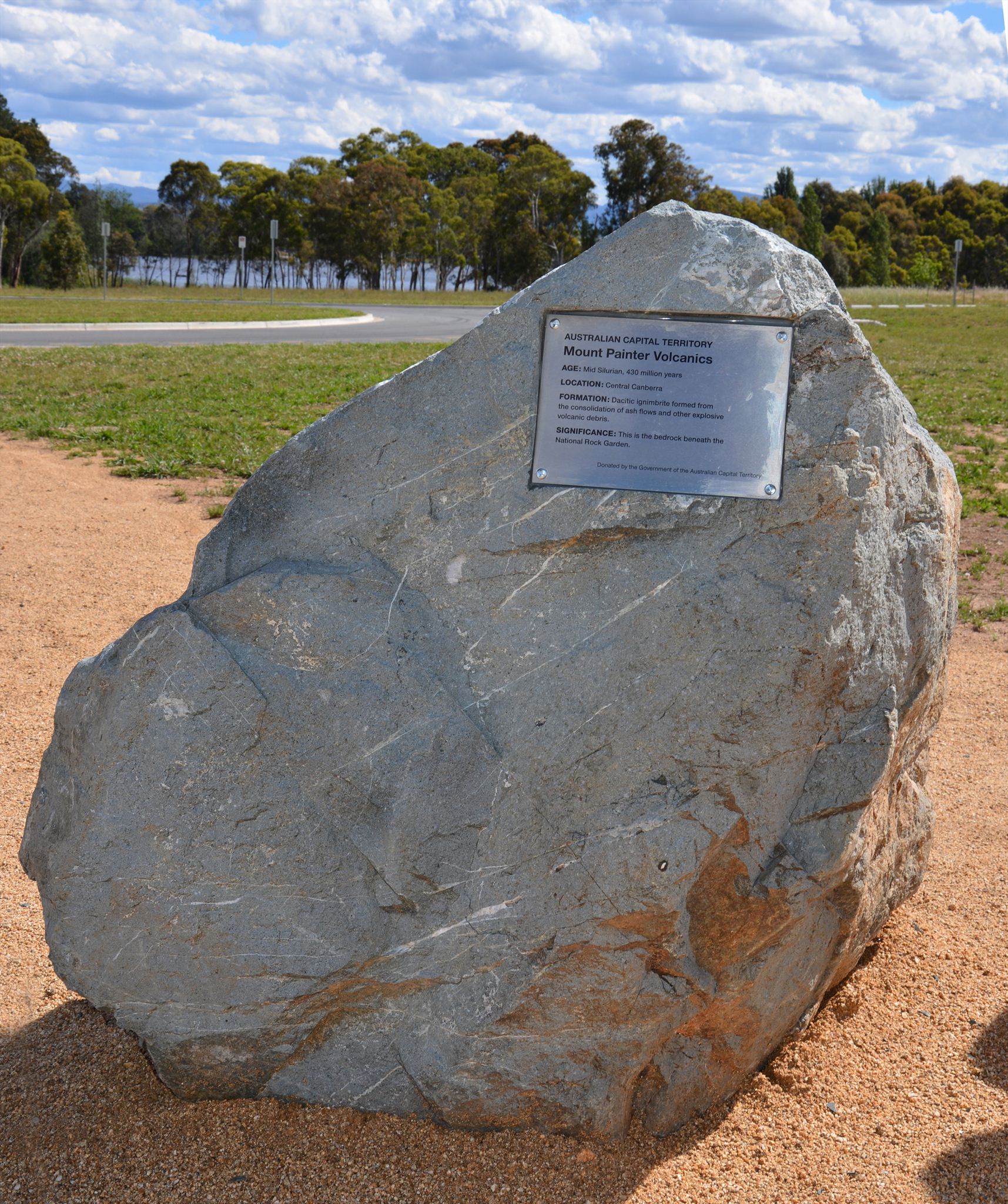 The Mount Painter Volcanics form a major part of the ACT's geological makeup. It is located in and around Central Canberra and was formed during the Mid Silurian Era, around 430 million years ago and is what you are standing on in the rock garden. The formation of the rock is described as 'Dacitic ignimbrite formed from consolidation of ash flows and other explosive debris'.
The Mount Painter Volcanics form a major part of the ACT's geological makeup. It is located in and around Central Canberra and was formed during the Mid Silurian Era, around 430 million years ago and is what you are standing on in the rock garden. The formation of the rock is described as 'Dacitic ignimbrite formed from consolidation of ash flows and other explosive debris'.
The rock described as massive blueish-grey dacitic crystal tuff. It contains garnet and chloritised cordierite. There is a local appearance of agglomerate and pumice. There are prominent quartz and feldspar phenocrysts. Xenoliths, or foreign materials, that are contained in the rock include jasperised sediments and there are some beds of tuffaceous siltstone and sandstone. They are mostly deposited from the air without water.
The Mount Painter Volcanics overlie the Walker Volcanics and Mount Ainslie Volcanics very uncomfortably, which can lead to geological instability in areas where this occurs. There is also nonconformity on the top, with the Yarralumla Formation, Deakin Volcanics and Yass Formation all lying above the Mount Painter Volcanics, at certain points, in a way that is uncomfortable.
NSW - Hawkesbury Sandstone
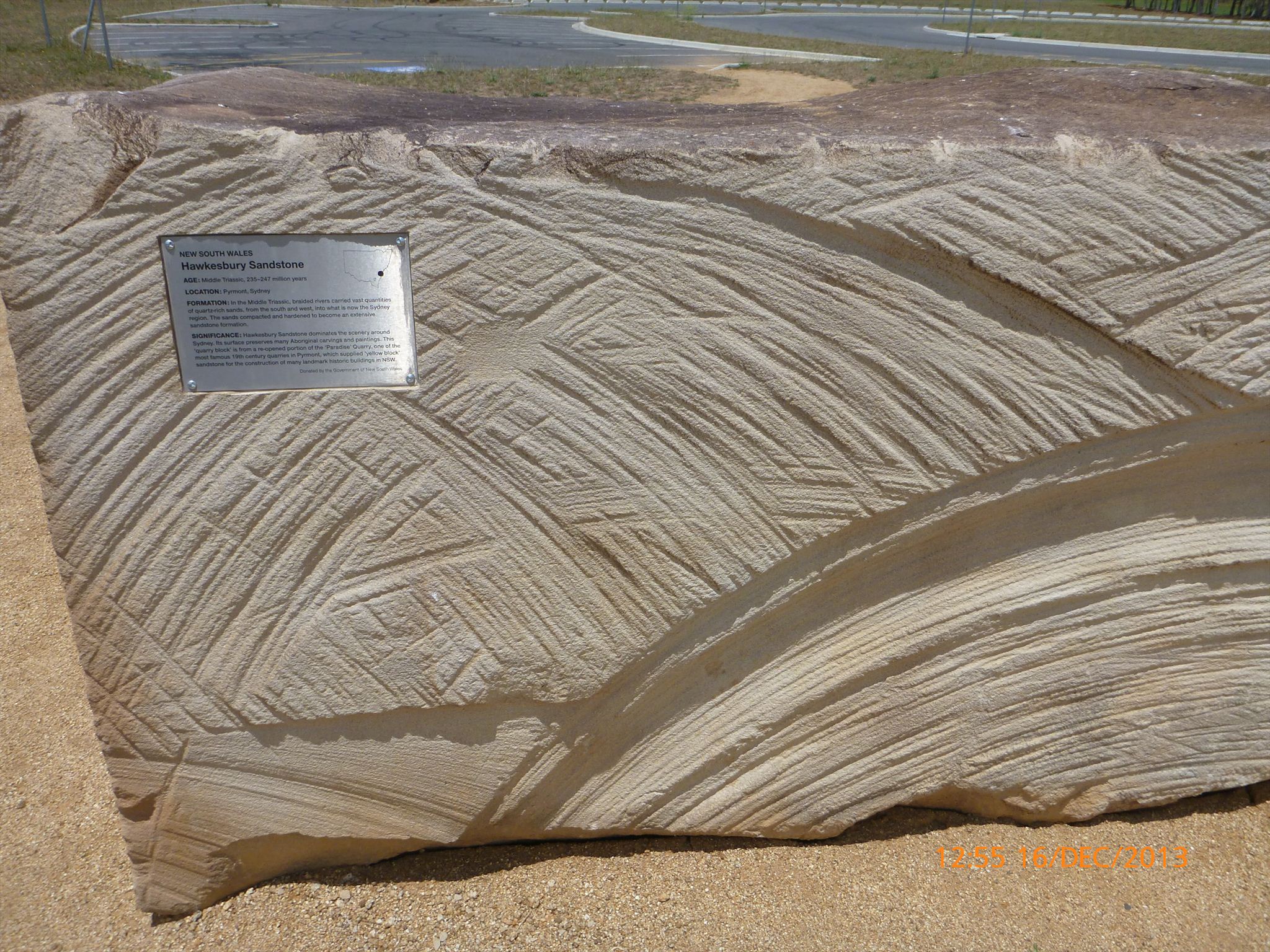 Hawkesbury Sandstone is predominantly found around Pyrmont in Sydney and was formed around 235-247 million years ago in the Middle Triassic period. The formation of the rock is described as 'braided rivers carrying vast quantities of quartz-rich sands, from the south and west, into what is now the Sydney region. The sands compacted and hardened to become an extensive sandstone formation'.
Hawkesbury Sandstone is predominantly found around Pyrmont in Sydney and was formed around 235-247 million years ago in the Middle Triassic period. The formation of the rock is described as 'braided rivers carrying vast quantities of quartz-rich sands, from the south and west, into what is now the Sydney region. The sands compacted and hardened to become an extensive sandstone formation'.
Hawkesbury Sandstone is the caprock that controls erosion and and the scarp retreat of the Illawarra escarpment. Six kilometers of the sandstone and shale lies beneath Sydney. In Sydney sandstone, the ripple marks from the ancient river that brought the grains of sand are distinctive and easily seen, telling geologists that the sand comes from rocks formed between 500 to 700 million years ago far to the south. This means that the highest part of the visible lines almost always faces approximately south
It is a very porous stone and acts as a giant filter. It is composed of very pure silica grains and a small amount of the iron mineral siderite in varying proportions, bound with a clay matrix. It oxidises to the warm yellow-brown colour that is notable in the buildings which are constructed of it. It dominates the scenery around Sydney. Its Surface preserves many Aboriginal carvings and paintings.
The sand was washed from Broken Hill, and laid down in a bed that is about 200 metres thick. Currents washed through it, leaching out most of the minerals and leaving a very poor rock that made an insipid soil. They washed out channels in some places, while in others, the currents formed sand banks that show a characteristic current bedding or cross-bedding that can often be seen in cuttings. At a time in the past, monocline formed to the west of Sydney. The monocline is a sloping bend that raises the sandstone well above where it is expected to be seen, and this is why the whole of the visible top of the Blue Mountains is made of sandstone.
The block at this site is a 'quarry block' from a re-opened portion of the 'Paradise' Quarry, one of the most famous 19th century quarries in Pyrmont, which supplied 'yellow block' sandstone for the construction of many landmark historic buildings in NSW.
TAS - Tasmanian Dolerite
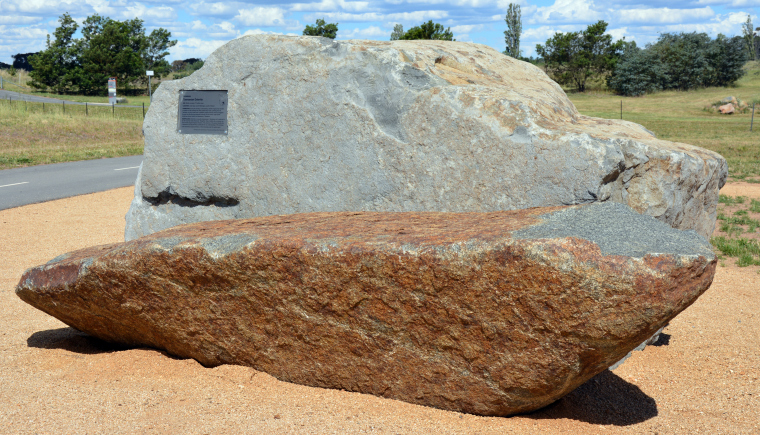
Tasmanian Dolerite was formed during the Middle Jurassic period, around 175 million years ago. It is found throughout Tasmania but the origins of this block are from near Leslie Vale, near Mount Wellington, south of Hobart. The formation of the rock is described as 'During the breakup of Gondwana, dolerite magma was injected as dykes and sills (sheets) into thick sedimentary rocks, covering most of Tasmania. As they cooled and crystallised, regular vertical cracks propagated through the sills forming polygonal columns and the iconic 'Organ Pipes' landscape above Hobart and elsewhere in Tasmania.
Tasmania has the world's biggest exposure of diabase or dolerite. The rock record contains representatives of each period of the Neoproterozoic, Paleozoic, Mesozoic and Cainozoic eras. It is one of the few southern hemisphere areas glaciated during the Pleistocene with glacial landforms in the higher parts. The west coast region hosts significant mineralisation and numerous active and historic mines.
The rock has also directly affected the biology of the island, creating unique habitats for plants and animals; indeed, it was the botanist, Robert Brown, who made the first recorded geophysical observation related to dolerite - when he climbed Mt Wellington in 1804 and noted that the "perpendicular rocks atop Table Mountain affected the compass needle".
Dolerite is usually widespread in Tasmania, and is referred to as 'the rock that made Tasmania'. Altogether, these multiple sills comprise one of the world's largest magma intrusions. The presence of the same dolerite sills in Antarctica and South Africa contributed to our understanding of the breakup of the Gondwana supercontinent, of which Australia was the easterly part.
SA - Oorlano Metasomatite
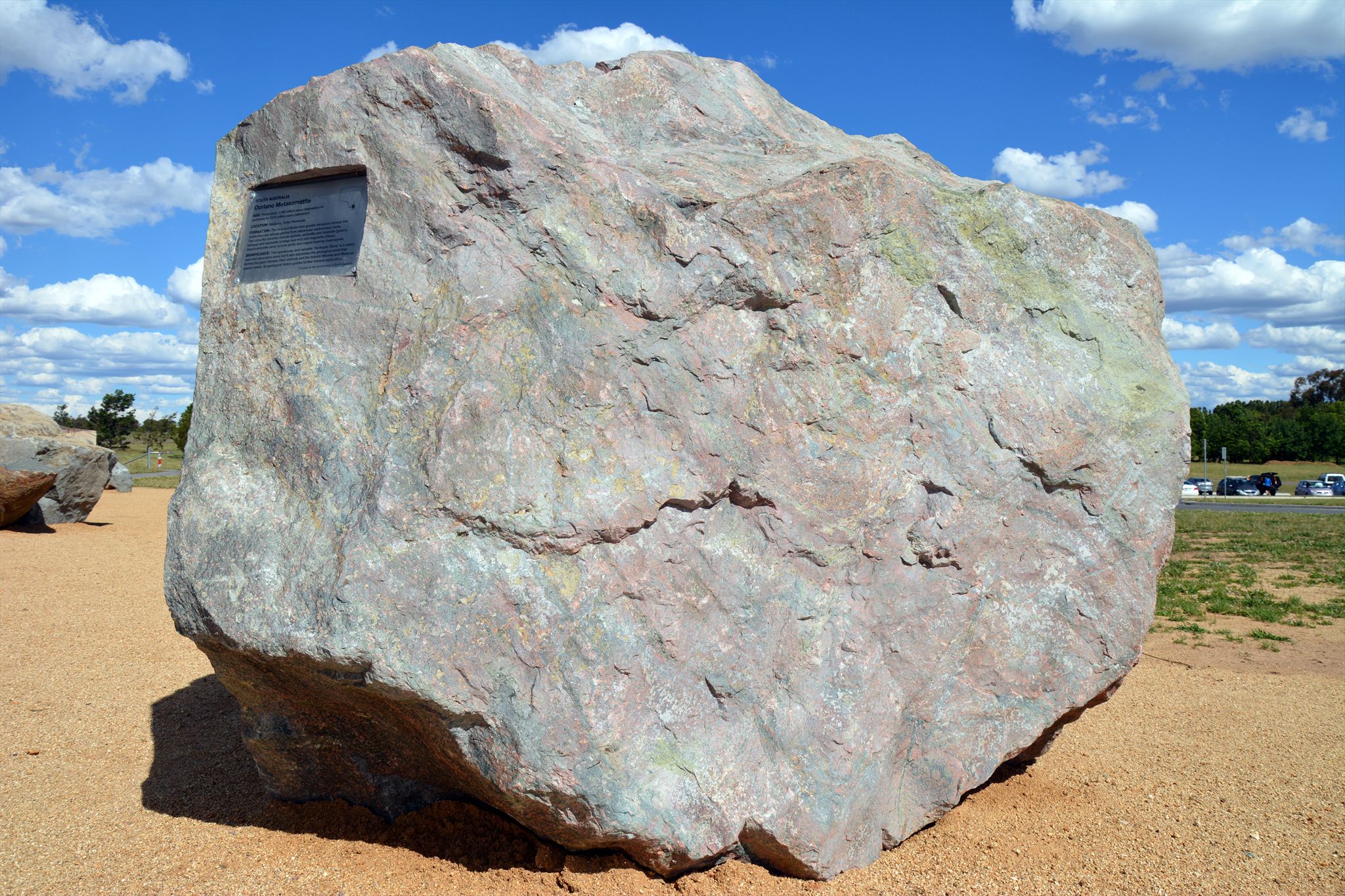 Oorlano Metasomatite was formed during the Proterozoic era. The rock was deposited around 1760 million years ago and altered around 1575 million years ago. This block came from around Wallaroo on the Yorke Peninsula. The heat and fluids from granite intrusions formed this distinctive calc-silicate gneiss from calcareous sedimentary rocks. The colourful minerals include epidote, actinolite and diopside (green); feldspar and haematite (orange and red) and magnetite (black). Quartz-dolomite veins include pyrite and copper-bearing chalcopyrite.
Oorlano Metasomatite was formed during the Proterozoic era. The rock was deposited around 1760 million years ago and altered around 1575 million years ago. This block came from around Wallaroo on the Yorke Peninsula. The heat and fluids from granite intrusions formed this distinctive calc-silicate gneiss from calcareous sedimentary rocks. The colourful minerals include epidote, actinolite and diopside (green); feldspar and haematite (orange and red) and magnetite (black). Quartz-dolomite veins include pyrite and copper-bearing chalcopyrite.
This is a spectacular and valuable rock, 'Harlequin Stone', and it is a widely exported decorative stone. It also expresses the geological event that formed the giant Olympic Dam orebody as well as the Moonta and Wallaroo copper mines. The geological history of this rock guides further mineral exploration in the area.
VIC - Bendigo metasandstone
 Bendigo Metasandstone was formed during the Ordovician and Silurian eras, around the time of 460-440 million years ago. This example of the rock comes from the Bendigo area. The rock was formed in a very complex manner. It began with the deposition of sand and mud in the ocean off ancient eastern Australia. Next there was immense upheaval that, with the help of heat and pressure, folded and metamorphosed the sediment to form this metasandstone and slate. This rock contains white quartz veins with pyrite. It also contains small grains of gold that formed from hot fluids that were injected into the slate.
Bendigo Metasandstone was formed during the Ordovician and Silurian eras, around the time of 460-440 million years ago. This example of the rock comes from the Bendigo area. The rock was formed in a very complex manner. It began with the deposition of sand and mud in the ocean off ancient eastern Australia. Next there was immense upheaval that, with the help of heat and pressure, folded and metamorphosed the sediment to form this metasandstone and slate. This rock contains white quartz veins with pyrite. It also contains small grains of gold that formed from hot fluids that were injected into the slate.
This rock was common in the area around the famous Bendigo Goldfields, that yielded vast quantities of gold during Victoria's gold rush era in the 19th and 20th centuries. This is why it is a significant rock for this collection.
QLD - Chinaman Creek Limestone

Chinaman Creek Limestone was formed during the Devonian Era around 390-400 million years ago. This sample comes from a location 220 km west of Townsville. It was formed from an accumulation of calcareous mud in a tropical, shallow marine environment on the east Australian continental margin. The rock contains many fossilised bivalves, corals, sponges and brachiopodes, including shells of giant megalodont clams. Many of these are preserved in their upright growth position.
This limestone is a major component of the Broken River group. It formed as a broad shelfal succession in the northern part of the Graveyard Creek Subprovince, southwest of Greenvale in north Queensland.This formation can be up to almost 800 meters thick. It consists largely of clastic limestone intervals up to 250 m thick of very thick to thin-bedded calcirudite and calcarenite and sporadic, thin interbeds of calcareous mudstone, siltstone and sandstone. As well as this, there are occurances when ore substantial siliciclastic intervals of lithic sandstone, siltstone and mudstone, and rare conglomerate up to 100 m thick are interlayered.
Reefal limestone intervals up to 30 m thick and 2 km long are locally represented in the unit, mainly in its lower parts. These are mainly stromatoporoid–heliolitid–rugose coral framestone, with prominent heads of the rugosans Endophyllum and Phillipsastraea in the upper and lower parts of the succession, respectively
This limestone is described as 'abundantly fossilferous' and can be regarded as a Devonian precursor of the Great Barrier Reef, the reef being Queensland's most iconic natural feature. The limestone is a spectacular decorative stone and is exported around the world. Other forms of Devonian limestone are extensively used in the manufacturing of cement.
NT - Mount Goyder Syenite
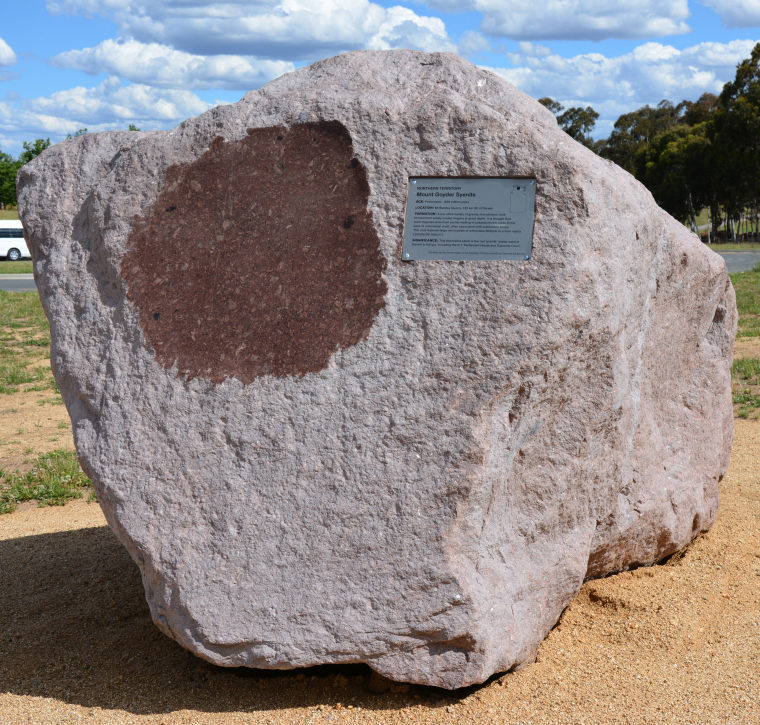 Mount Goyder Syenite was formed during the Proterozoic era, around 1825 million years ago. The origin of this example lies at the Mt Bundey Quarry, 120 km south-east of Darwin. This rock was formed from slowly cooled magma at a great depth. It is thought that such magmas arise from the partial melting of potassium-rich rocks at the base of continental crust. This is often associated with subduction zones. This rock, therefore, is a low silica variety of granite. It is also classified as a plutonic rock, due to the way it was formed, as described above.
Mount Goyder Syenite was formed during the Proterozoic era, around 1825 million years ago. The origin of this example lies at the Mt Bundey Quarry, 120 km south-east of Darwin. This rock was formed from slowly cooled magma at a great depth. It is thought that such magmas arise from the partial melting of potassium-rich rocks at the base of continental crust. This is often associated with subduction zones. This rock, therefore, is a low silica variety of granite. It is also classified as a plutonic rock, due to the way it was formed, as described above.
This rock is significant because it is the most commonly used decorative stone in many buildings in Darwin. This includes the NT Parliament hose and the Supreme Court in Darwin.
ACT - Canberra Limestone
 Canberra Limestone was formed during the Mid Silurian era, around 430 million years and is prominent around Central Canberra. There are some outcrops of this rock, especially around the Molonglo River but many of these are now covered by Lake Burley Griffin. The limestone was formed in warm and shallow tropical seas, on the margin of continental Australia. At this time, Australia was still part of the supercontinent, Gondwana. Marine life was abundant as well. This formation is a minor, but distinctive part of the sandstone, siltstone and mudstone that makes up the Canberra Formation. There is, occasionally, fossilized fragments of coral and shell washed in with other sediments.
Canberra Limestone was formed during the Mid Silurian era, around 430 million years and is prominent around Central Canberra. There are some outcrops of this rock, especially around the Molonglo River but many of these are now covered by Lake Burley Griffin. The limestone was formed in warm and shallow tropical seas, on the margin of continental Australia. At this time, Australia was still part of the supercontinent, Gondwana. Marine life was abundant as well. This formation is a minor, but distinctive part of the sandstone, siltstone and mudstone that makes up the Canberra Formation. There is, occasionally, fossilized fragments of coral and shell washed in with other sediments.
Due to the number of outcrops of this rock before the Lake Burley Griffin was filled, around 1963-64, early Europeans referred to the area as the 'Limestone Plains'. This was the general name for the region that is now Canberra. Over time, the colour of the rocks has become darker than what this example presents. The rocks are Quartz-rich with some sparsely distributed fragmentary macro fossils of corals and shells. A good example of an outcrop that is still visible is here.
To log a find
You MUST email me with the following answers to log a find;
WP1
- What is the size of the crystals? What is the color?
WP2
- What are the two visible colors on the smooth side?
WP3
- What is the texture of the black part of the rock?
- Is the vein at this location horizontal or vertical?
WP4
- What happens to the rock in the middle?
WP5
- How many metal poles raise the rock on top?
WP6
- Is there yellow on the rock?
WP7
- What is the size of the crystals? What is their color?
WP8
- How big are the crystals?
Sources
(Click Here) (Click Here) (Click Here)(Click Here) (Click Here) (Click Here)
Additional Hints
(No hints available.)